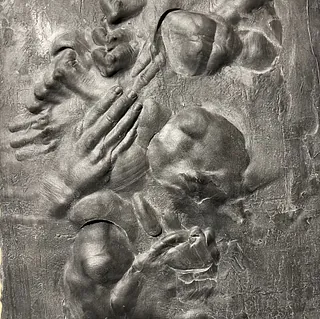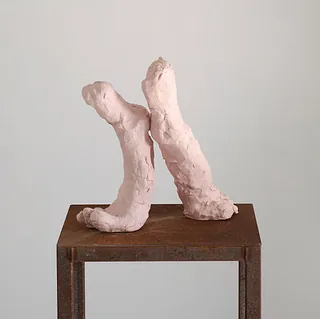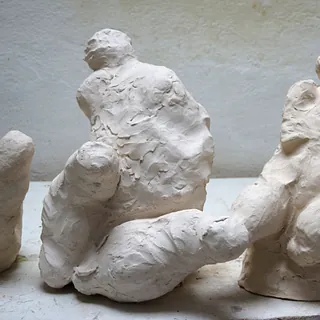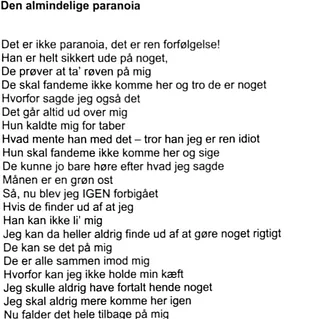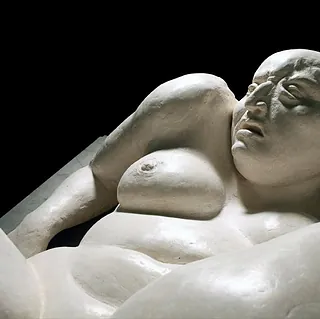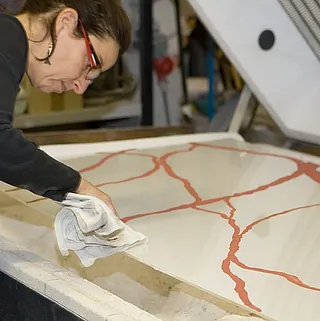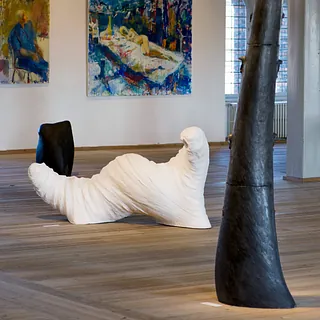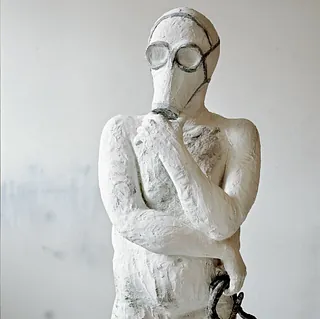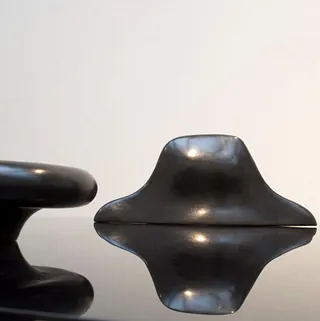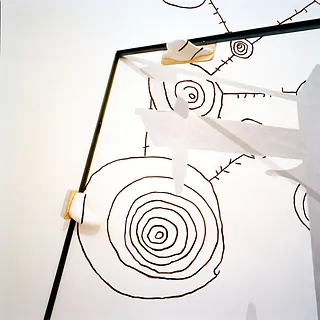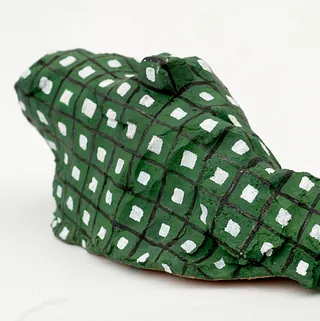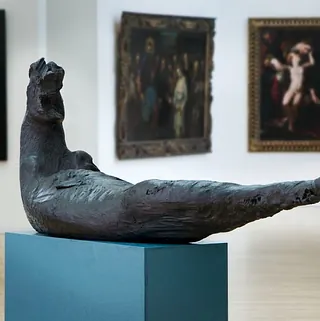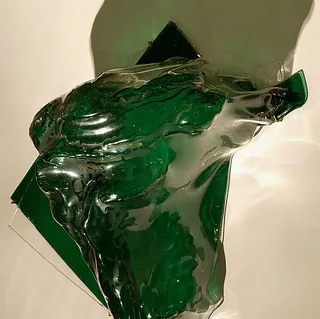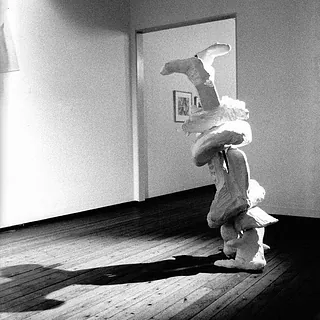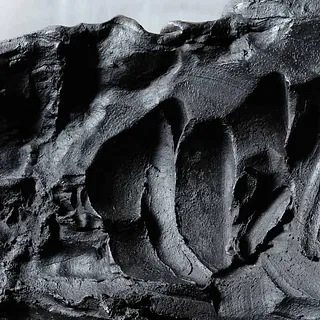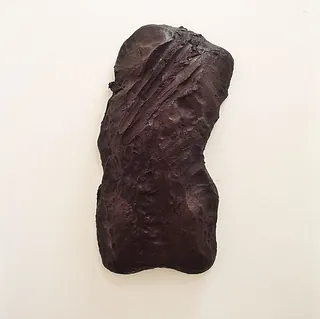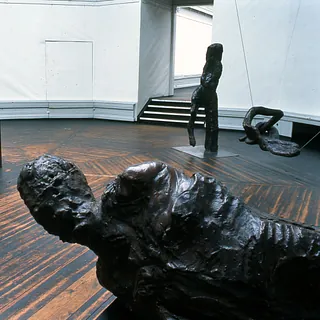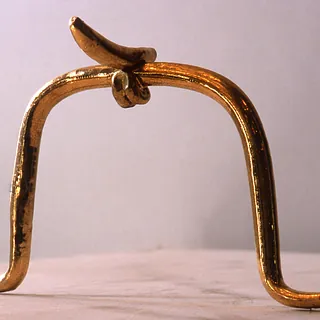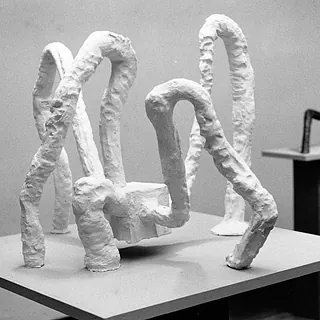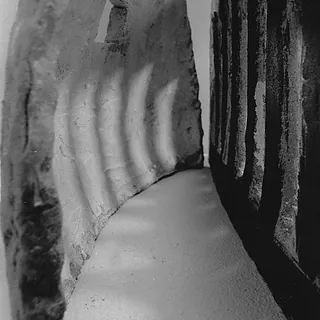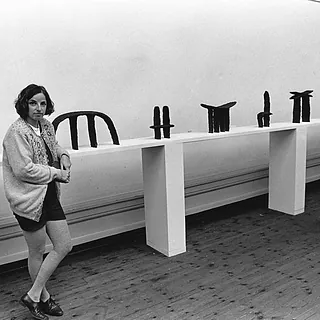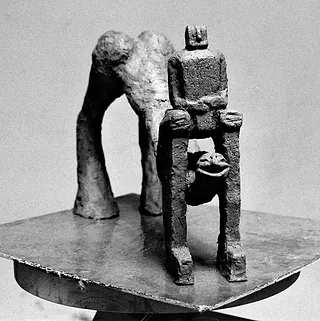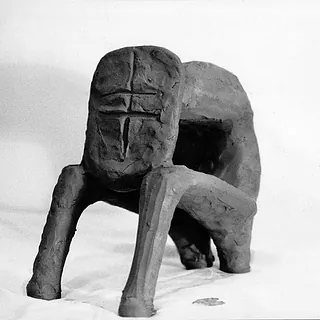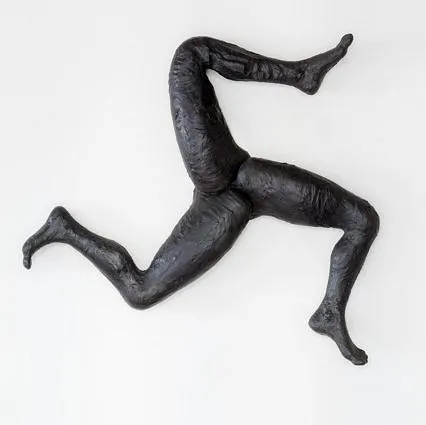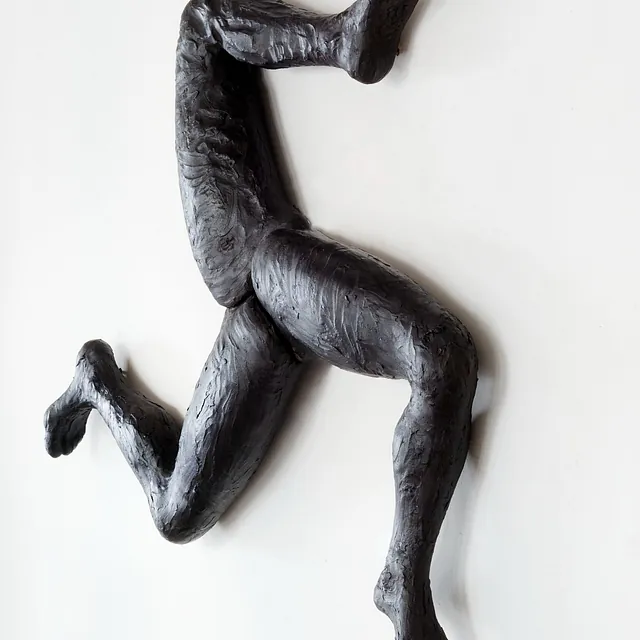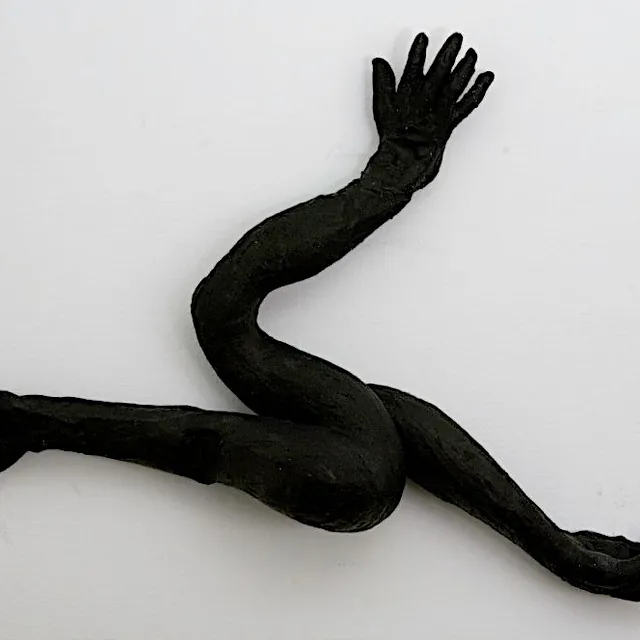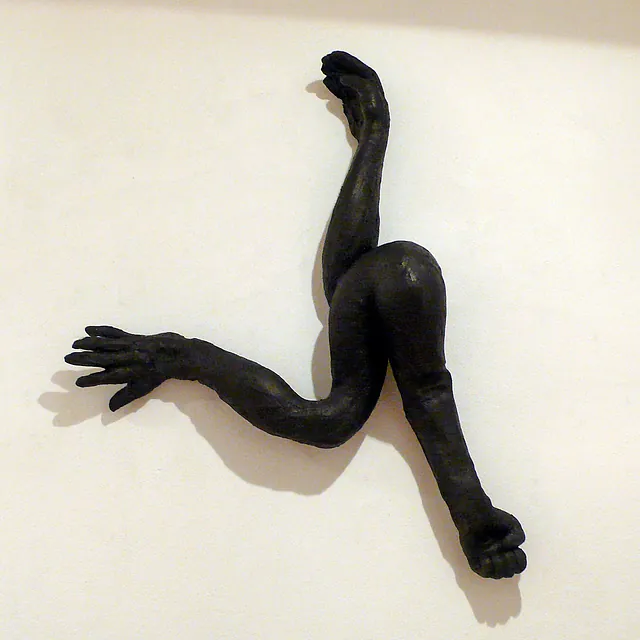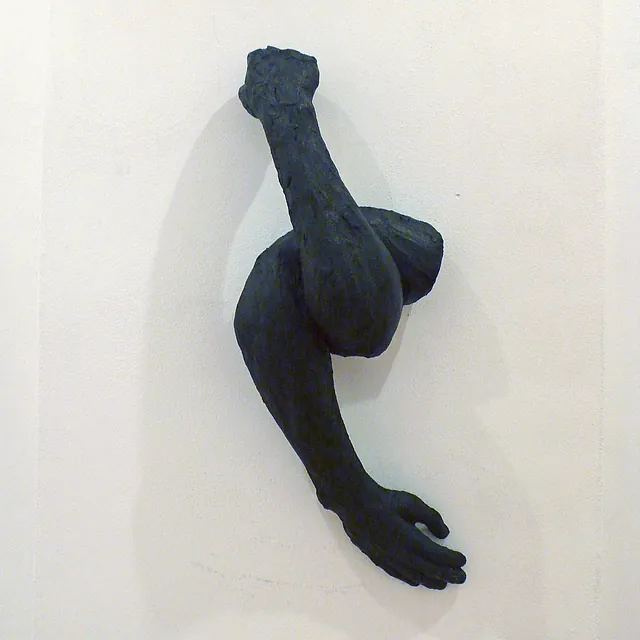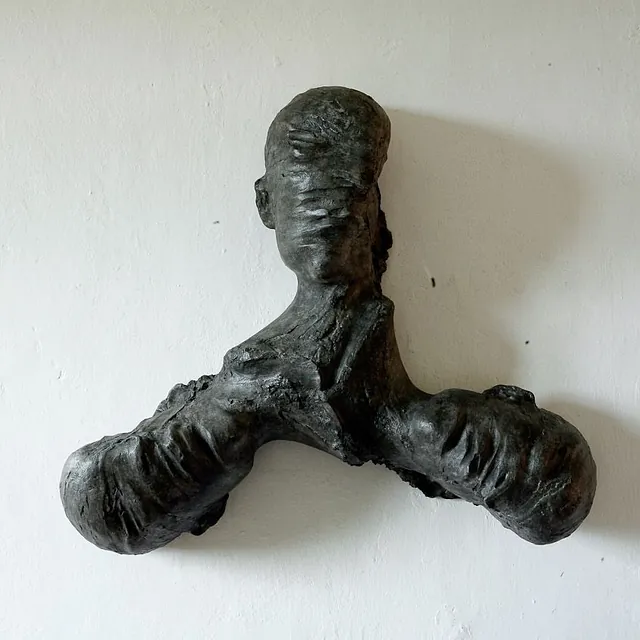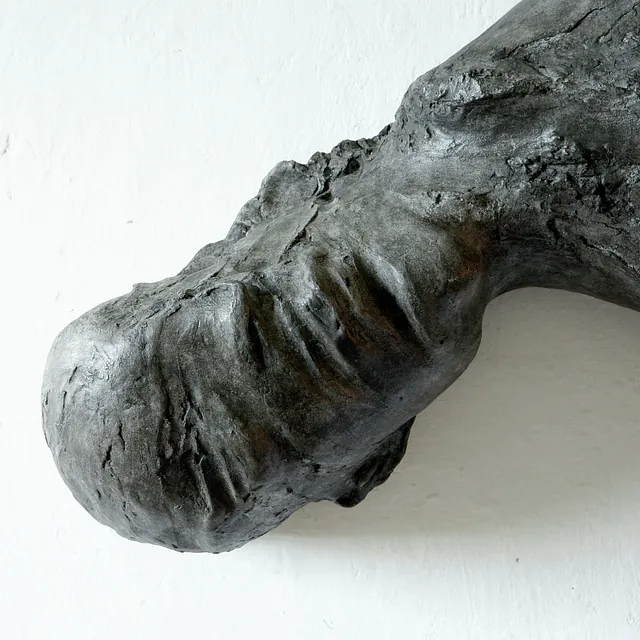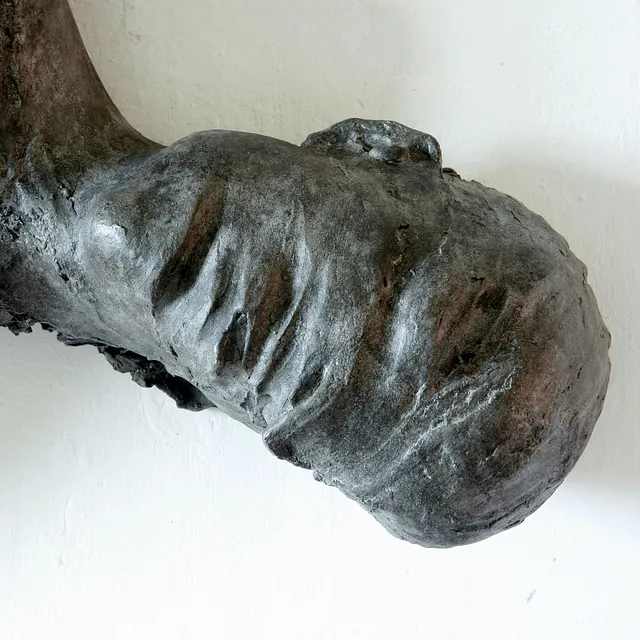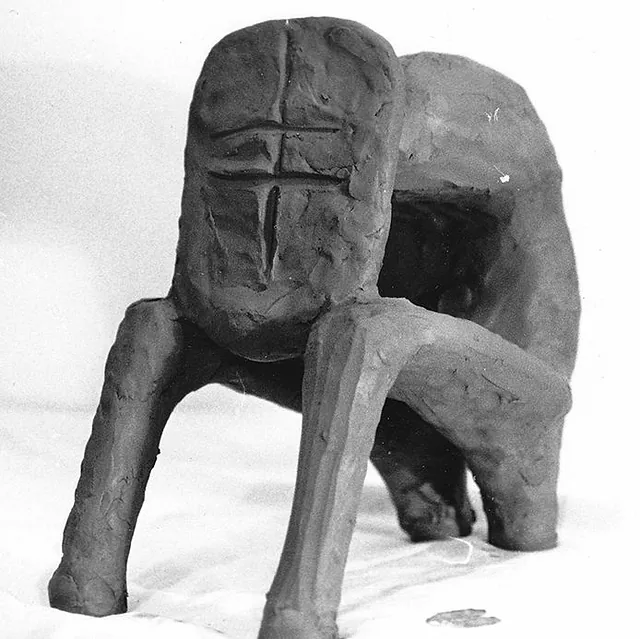SCULPTURE
AND RELIEF
... I create movement in the sculpture by making a difference in the proportions so that the eye moves around the figure. There is always movement in my sculptures even though the movement is minimal. When the difference in proportions fluctuates relative to each other, the sculpture becomes spatial and will therefore relate to any space...
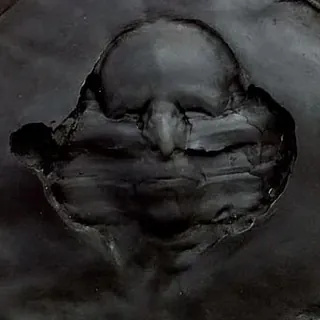
Performance in clay, 2010
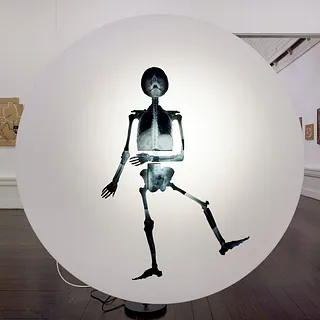
Our reality, their illusion, 2009
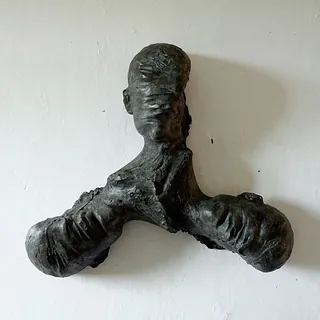
Times Alphabet, 2007-2008
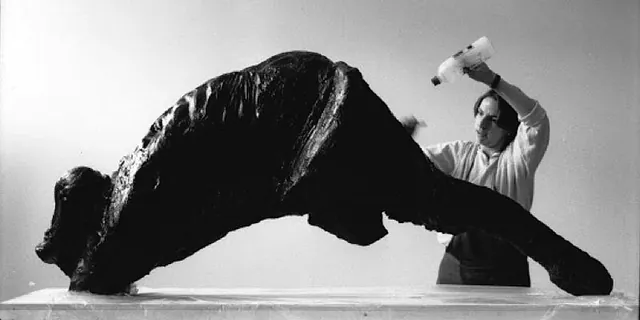
Portraits of Eli Benveniste by photographer Heine Pedersen
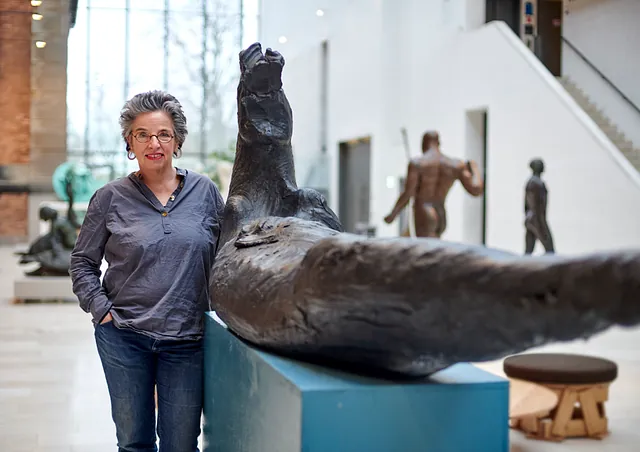
thrown into the world, 2024-25
Over the past year, I’ve been working on this series of ceramic reliefs, and sculptures. Each relief is modelled on nature’s terms, so to speak, letting the material come into its own.
The three ceramic reliefs from the series "Thrown into the World" (Archive Numbers 270, 271, and 272)
explore the beauty of chance, the strike of a moment in a movement, preventing the ego from interfering.
Thrown into the world 2024-25, is a new series of ceramic reliefs and sculptures. The works appears “untouched”, except for the decisive gesture of the hand that created them.
Thrown Into the World showcases Eli’s latest “untouched” ceramic reliefs, some of which are cast in silicone rubber for the exhibition at Tings Art in Lisbon.
Eli’s playful use of rubber, with its soft-yet-tough doll feel, transforms classic clay reliefs into something totally fresh-funky, cool, and surprisingly tactile. The precision of the rubber impressions is striking.
Rubber might not seem noble, but in Eli’s hands, it’s absolutely contemporary. There’s a certain irony here – progress pulling us forward and backward at the same time: from humanity’s first material to one that seems to be our last.
' ... Eli Benveniste's latest sculpture project consists of a series of feet, detached from such diverse figures as a ballet dancer, the fairy tale Klods-Hans and a particularly sexually excited Japanese woman, taken from a woodcut that Benveniste has hanging in his bedroom ... '
Trine Ross, 2020
FEET, 2020
Why Feet? I began doing them already in Portugal last summer - long before we knew anything about the corona virus and the consequences we all would have to deal with.
A work process often begins by with the circumstances we find ourselves in. In this case I had to do smaller sculptures, if I wanted to work in my newly restored studio in Portugal; sizes which later could be transported back to Italy in our car. But I also Liked the idea of looking closely into a specific detail of the body.
But why feet exactly? To me a foot is a kind of sculpture in itself, it has this particular triangular form, similar to the rhythm a conductor draws in the air, with his beat.
A form who closes upon itself in a very natural way. I discovered that they could be turned upside down, stand, lay and be distorted in every way and be expressive even with a few touches.
I started with a smaller foot, just the foot itself with no ankle. It became the foot of the Boor bog man or the Tollund man, that was found in bog land after more than 2000 years. Then I did "Blockhead Hans" foot - from the story of H.C. Andersen, a joyful peasant’s foot and after that, the small delicate foot of a Japanese lady having an orgasm, as I had seen on the Japanese prints we have in our bedroom in Portugal. Always the same clenched feet like a fist, so well expressed and not to be misunderstood.
A new piece turned out to be a refugee’s foot; a foot that had walked thousands of miles, tired and hardened and marked by the many steps taken under heavy burdens.
Back in Italy the series evolved in a more imaginative direction. Apparently, it was not necessary to make a whole body, let alone a face, to express a condition or situation, it could all be contained in there, abstract and yet recognizable at the same time.
I squeezed the clay so it took shape from my hands and turned into a kind of a tree, which were followed by some more optimistic and playful feet. Lately I am making ballet feet. As they can’t stand on their own tip toe, I had to make the better half - and they became a pair - an etude.
The fact they were a pair, suggested some pretty wild compositions and sculpturally that's where it started to get really interesting, because something new, which I hadn’t expected, came up due to pure necessity. And I haven’t finished yet.
Eli Benveniste 2020
Photographer © Sylvain Deleu
Thanks to all who gave me their time and also a bit of their soul; allowing me to meld their features into clay
Portraits of my friends, 2021 ongoing
The portraits were chosen at random, it was more a coincidence: friends from Pietrasanta who had some time to dedicate or friends visiting from abroad. No intention really, no ambition for anything specific except to watch and let my hands follow my eyes and sometimes vice versa, when my hands "saw more than my eyes could see at the moment".
Thanks to all who gave me their time and also a bit of their soul; allowing me to meld their features into clay.
1. Georg Victor, German sculptor, Pietrasanta, 2015
2. Peter Poulsen, Danish poet, 2015
3. Ron Mehlman, American sculptor, Pietrasanta, 2016
4. Alena Matejka, Czech stone and glass sculptor, March 2016
5. Lars Kærulf Møller, museum director, May, 2016
6. Caterina Belle, teacher, Verona, May 2017
7. Raffaello Bassotto, photographer, Verona, May 2017
8. Dino Raymond Hansen, Danish film producer, October 2017
9. Giovanni Meloni, Veronese painter, May 2018
10. Trine Ellitsgaard, contemporary textile artist, June 2018
11. Henrik Norbrandt, Danish poet - with and without donkey ears as Henrik wanted, June 2018
12. Jørgen Haugen Sørensen, modeling my husband Jørgen Haugen Sørensen asleep in a chair, June 2018
13. Henning Camre, Danish cinema and film industry administrator, January 2019
14. Regitze Oppenhejm, Project Development, Legal Affairs Consultant, January 2019
15. Thomas Boberg, Danish poet and translator, son of the poet Jørgen Boberg, January 2020
16. Cher Lewis, Pietrasanta, February, 2021
17. Crying boy, Matthias Grünewald tegning, February 2021
18. Patricia Franceschetti, photographer, Pietrasanta, March, 2021
In development:
19. Morten Søndergaard, Danish writer, translator, proofreader and artist, August 2018, April 2019, March 2021
20 Salvatore Mazza, March 2021
And more …
Eli Benveniste 2020
Tendency to gang Up, 2016
Eli Benveniste, 2019
For a long time I have made sculptures according to drawings, they are not only sketches but actual recipes. I read the drawing contour three-dimensionally. The outline of a sculpture from a certain angle. At the same time, there are many possibilities within the framework of a line drawing and the sculptures I show here are variations over the same contour drawing.
When I drew the drawing, my idea was that the front of the body could be read as a back, as if the body had turned, while the "legs" were still coming out from the hips.
I sought a certain spatiality and wanted to express the essence of a movement.
As for the modeling, I thought, how little is needed? Where does the boundary between unrecognizability go to where I have, in fact, gone too far, when the desire to make my idea visible instead gets the first freshness that naturally arises during the construction of a sculpture killed. That's why I released them as soon as possible, when they were just as readable, caught in the moment.
The five sculptures have now been raw-burned in my workshop for two years, without being finished. They were from that time the Colorists no longer had to exhibit on the Free. Now the Colorists are back on and I continue where I left off, and have made two more variations. Those who lacked to complete the series of "Tendency to gang Up".
Photographer © Eli Benveniste
A Matter of Empathy, 2015
Manifesto 1. The creative, the conservative and the destructive man
Manifesto 2. The Missing Link
Manifesto 3. We do it because we can - A timeline
Manifesto 4. The common man's paranoia
Manifesto 5. If Only
"A Question of Empathy" A video screenplay from the Round Tower 2011,
Filmed and cut by Eli Benveniste, duration 9 mm
Ornamental Tales, 2014
For a ceramic exhibition, at Galleri R2 in Bornholm in 2014, I made a number of plates. I call them "Ornamental tales" because it is the ornament, in relation to the shape I have been working with. The more than 3000 year old Minoan art from Crete has always fascinated me and there are some jars from here, with painted red octopusses, where the ornament is so perfectly adapted to the shape of the jar and at the same time depicts a very lifelike octopus that has sent me in this direction.
But I did not paint the surface, but instead scratched figures into the clay and glazed the line. It has been fun and interesting to go to another world and get to know the pottery technique and problems better.
It was a pleasant surprise to discover that my bronze sculpture Hippocamp from 2003, which was sold to the Danish National Gallery in 2007, was included in the exhibition "Danish artists over 150 years in the Sculpture Street at the Danish National Gallery.
Hippocamp is the result of a splicing between a horse that rolls in the snow and a Viking ship I had seen at the vikingtidsmuseet in Oslo.
The movement that sums up these elements are the elevation of the tall head in profile, which turns into the wide broad shape, is an expression that characterizes many of my sculptures.
Acqua passata and the shadows, 1999-2002
November 2000 - This Room is About
Clay, glass, light, water, plaster and shadows
Sculptures in clay - like earth, a body a thought of transit
Lighting houses - an atmosphere formed by the size and lightness of the room,
as the walls throw back.
Direct light - like dazzle
Indirect light - which can enhance a thought
Darkness - like memory, like black sculptures
Glass - like liquid water, of the same shape as shadows
Water - in motion, the memory brings with it in its flow
- Aqua Passata, lets go undone
Black sculpture - a dead without owner, colored by the water that drives by
Light - as now, as seeing, being conscious of one's thoughts
Glass sculpture - in the form of a reverse mountain filled to the brim with water
lets light pass through it,
to gather its shape into a single luminous point
Shadows - make even dead things come alive,
Do not discern, do not judge, forget no one
bound to the light, long for the darkness that will overshadow them
Light shadows - which cast diffused light on black living sculptures of dead
Dark water - reflecting the light
Water in motion - which blurs its reflection
White shadows - like inverted sculptures
White sculptures - casting black shadow


